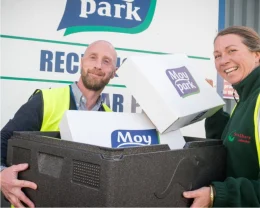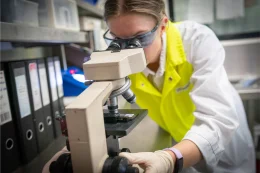
Our 2024 Progress
While our sustainability efforts are constantly evolving, our vision remains consistent — to be the most respected company in our industry and to help create a brighter future for our team members. We take pride in being a trusted part of family meals around the world, and we are dedicated to continually improving our processes to achieve both our global and regional sustainability goals.
* Safety Index = number of severe injuries for every 100 employees ((Severe Injuries*200,000)/Total Hours Worked). Severe Injury = Any injury resulting in amputation, fatality, in-patient hospitalization, vision loss, second- or third-degree burns, or fractures that results in greater than fifteen days lost time, and any other injury that results in greater than fifteen days lost time.
** Depending on the time of receipt, JBS/Pilgrim's Ethics Line cases may not be closed within the same calendar year.
*** Includes concerns about the company’s potential and actual negative impacts on stakeholders. Pilgrim's defines these cases as those related to anti-bribery/anti-corruption (ABAC), antitrust, embezzlement, falsification of corporate documents, financial wrongdoing, theft over US$ 2,000, and conflicts of interest.
When used, “net zero by 2040” or “net zero by 2040 goal” shall mean the company’s goal to achieve net-zero greenhouse gas (GHG) emissions by 2040. This goal spans the company’s global operations, as well as its diverse value chain of agricultural producer partners, suppliers and customers, and all other third parties in the company’s value chains. Whether the company is successful in achieving this very ambitious goal will depend on numerous factors outside of the company’s control, including but not limited to: legal and regulatory changes by local governments, technological innovations and infrastructures, energy advancements, economic and environmental conditions, climate change impacts, force majeures, social and cultural factors, international agreements and global trends, financial markets, collaborations and partnerships, and the resources and efforts of those in our value chains. Because of these variables, among others, the company may not be able to achieve net zero by 2040.
* Safety Index = number of severe injuries for every 100 employees ((Severe Injuries*200,000)/Total Hours Worked). Severe Injury = Any injury resulting in amputation, fatality, in-patient hospitalization, vision loss, second- or third-degree burns, or fractures that results in greater than fifteen days lost time, and any other injury that results in greater than fifteen days lost time.
** Depending on the time of receipt, JBS/Pilgrim's Ethics Line cases may not be closed within the same calendar year.
*** Includes concerns about the company’s potential and actual negative impacts on stakeholders. Pilgrim's defines these cases as those related to anti-bribery/anti-corruption (ABAC), antitrust, embezzlement, falsification of corporate documents, financial wrongdoing, theft over US$ 2,000, and conflicts of interest.
When used, “net zero by 2040” or “net zero by 2040 goal” shall mean the company’s goal to achieve net-zero greenhouse gas (GHG) emissions by 2040. This goal spans the company’s global operations, as well as its diverse value chain of agricultural producer partners, suppliers and customers, and all other third parties in the company’s value chains. Whether the company is successful in achieving this very ambitious goal will depend on numerous factors outside of the company’s control, including but not limited to: legal and regulatory changes by local governments, technological innovations and infrastructures, energy advancements, economic and environmental conditions, climate change impacts, force majeures, social and cultural factors, international agreements and global trends, financial markets, collaborations and partnerships, and the resources and efforts of those in our value chains. Because of these variables, among others, the company may not be able to achieve net zero by 2040.
* Safety Index = number of severe injuries for every 100 employees ((Severe Injuries*200,000)/Total Hours Worked). Severe Injury = Any injury resulting in amputation, fatality, in-patient hospitalization, vision loss, second- or third-degree burns, or fractures that results in greater than fifteen days lost time, and any other injury that results in greater than fifteen days lost time.
** Depending on the time of receipt, JBS/Pilgrim's Ethics Line cases may not be closed within the same calendar year.
*** Includes concerns about the company’s potential and actual negative impacts on stakeholders. Pilgrim's defines these cases as those related to anti-bribery/anti-corruption (ABAC), antitrust, embezzlement, falsification of corporate documents, financial wrongdoing, theft over US$ 2,000, and conflicts of interest.
When used, “net zero by 2040” or “net zero by 2040 goal” shall mean the company’s goal to achieve net-zero greenhouse gas (GHG) emissions by 2040. This goal spans the company’s global operations, as well as its diverse value chain of agricultural producer partners, suppliers and customers, and all other third parties in the company’s value chains. Whether the company is successful in achieving this very ambitious goal will depend on numerous factors outside of the company’s control, including but not limited to: legal and regulatory changes by local governments, technological innovations and infrastructures, energy advancements, economic and environmental conditions, climate change impacts, force majeures, social and cultural factors, international agreements and global trends, financial markets, collaborations and partnerships, and the resources and efforts of those in our value chains. Because of these variables, among others, the company may not be able to achieve net zero by 2040.


